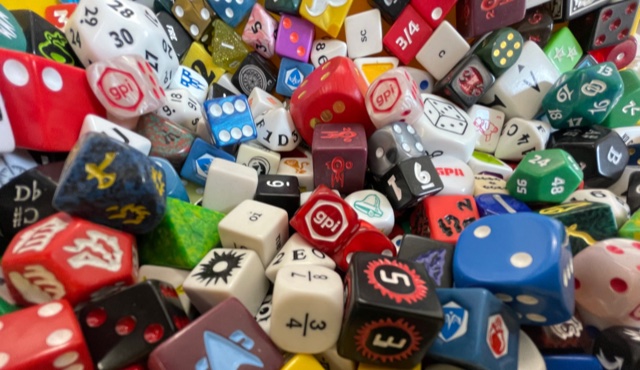The Beginning of the Affair (or Nerd Fest – potato, potahto)
Dice. We just love dice. It’s been a long-standing love affair here at GPI, between us and dice. I mean really, c’mon, dice are awesome. If you see a big pile of dice, what’s the first thing you are going to do? I bet you would instinctually dig your hands into that pile, come out with a fist full of them and begin rolling them.  I’m right, aren’t I? And not only that, while you imagine that scenario, I also bet you have a big smile on your face thinking about it.
Dice have been used for gaming and divination purposes for thousands of years. Evidence found in Egyptian tombs has suggested that this civilization used them as early as 2000 B.C. GPI’s history of dice hasn’t been around that long- ours started back in the 1970’s. John Fisher, GPI’s founder, left Milton Bradley to begin his own sourcing company and one of the components he sourced the most was, you guessed it, dice. Our GPI staff that came to us from our sister company, The Haywire Group, also have a strong pull towards dice. Their first tabletop game and what became their evergreen game, DICEcapades!, was all based on dice, and lots of them.  So yes, we love dice, it seemed to be “in the cards†for us from the beginning.
In the first 5 months of 2021 alone, GPI has manufactured over 23 million dice!
Dice can be manufactured from numerous materials and production methods. The variety of materials include molded plastics (urea, acrylic, expanded foam) also wood, metal, even stone. The most common dice are produced with plastic resins via injection molding or with urea via compression molding.
Very simply put, injection molding is accomplished with a specially designed mold that effectively resembles an industrial waffle iron. The two halves join together under extremely high pressure, liquefied plastic is pumped into a series of distribution tubes within the mold and fill up the cavities that are the negative shape of the die to be produced, the resin then cools down and hardens, and the mold then opens up and the dice come out.
Dice that are produced via injection molding are able to be color matched to printed materials by way of PMS (Pantone Matching System) numbers. The dice can be opaque, transparent, translucent, iridescent, glitter effect, a swirled combination of colors, and more. Surfaces can range from a highly polish gloss effect to matte, even a sand-tumbled to make the dice appear old and worn.
Compression molded dice using urea compound is what we all know of as traditional dice and dominoes. Urea compound starts out as a powdery or granular material, and it is turned into a solid using very high heat and pressure in a compression style mold. This is a very old style of molding- it’s been around for decades. Color options are much more limited to opaque white, black, ivory, red, blue, and green.
For all styles of dice, images on the surfaces can be custom molded and inked, pad printed, silk screened, or applied via heat transfer printing. A special ink wash technique is also a great choice to achieve a weathered or worn look.
Robotic equipment is now used to apply ink in standard spots or “pips†under high speed and accuracy, while the traditional manual inking application is still used for more intricate custom designs to ensure your dice are of the highest quality standard. That’s correct- workers actually still apply the ink manually by individually flooding the molded area of the image with ink on every surface of every die!
Needless to say, the options are extensive. GPI has the ability to manufacture 32mm D20 down to 5mm D6 dice, and everything in between or beyond.  Dice, frankly, don’t get enough credit for being a creative component of a game. Every year, we are pushing the envelope to see what new materials, new finishes, and innovative bend that we can put on dice.


Recent Comments